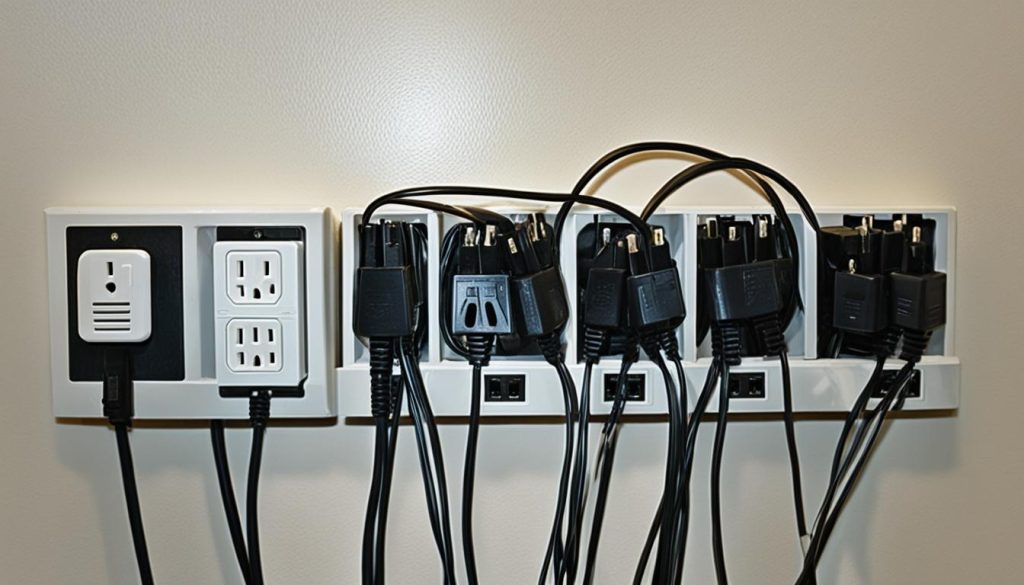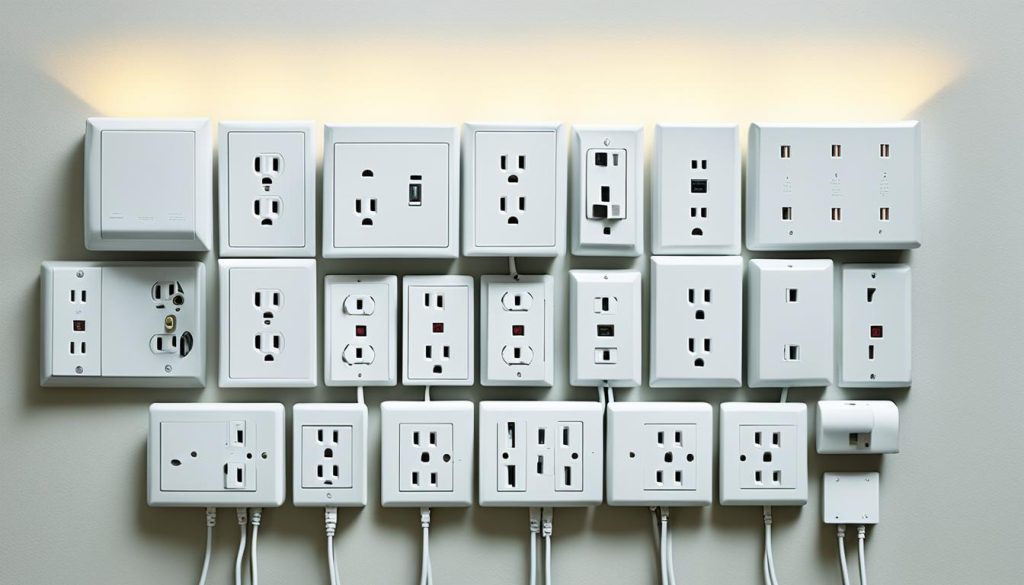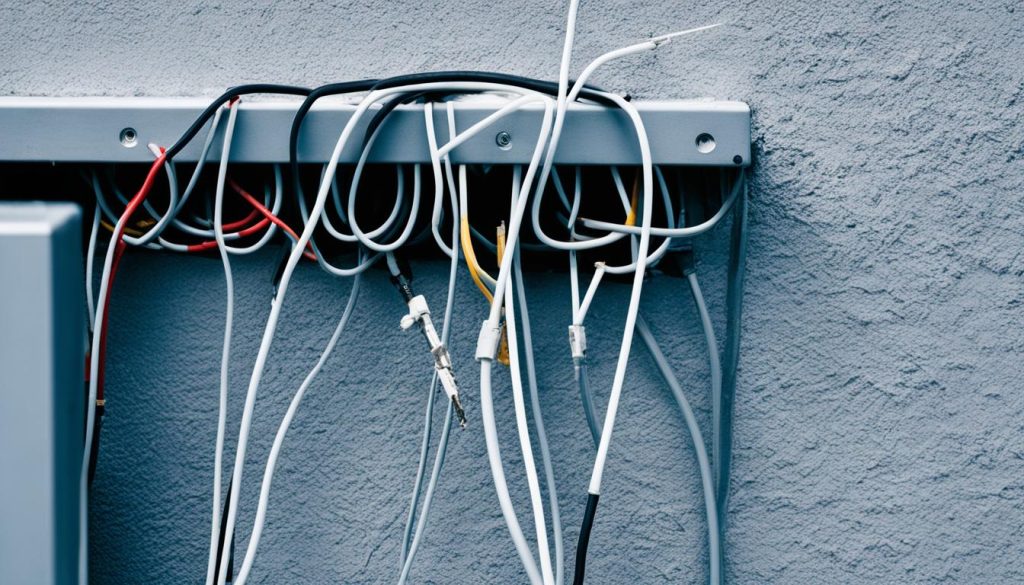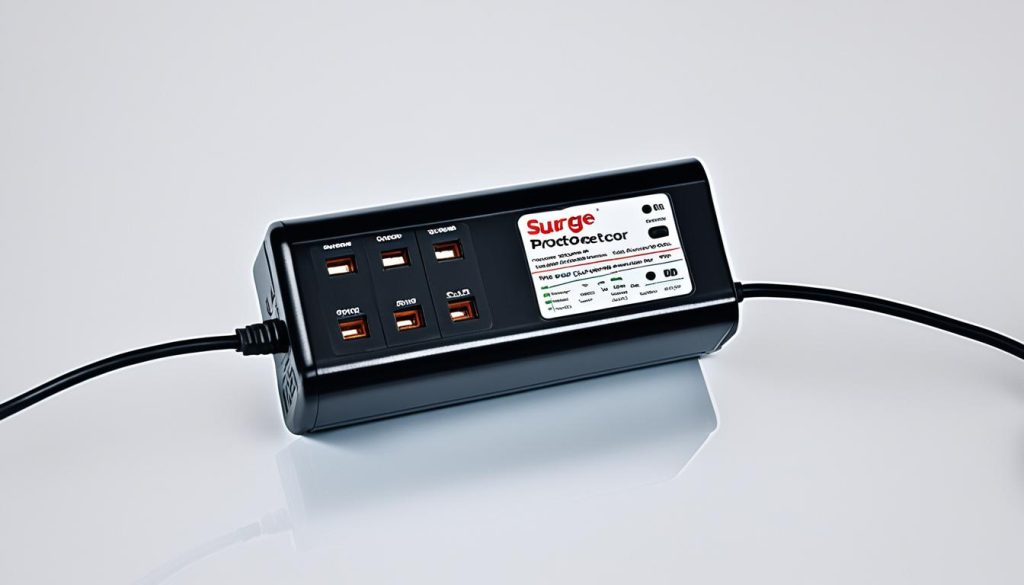Surge protectors are a crucial component for the safety and protection of your valuable electronics in your modern household. Understanding the importance of surge protectors and following proper guidelines can help you make an informed decision about their necessity.
Key Takeaways:
- Surge protectors play a vital role in protecting your electronic devices from power surges.
- Proper understanding and utilization of surge protectors can contribute to the safety of your home.
- Following guidelines for surge protector usage can maximize their effectiveness.
- Investing in surge protectors is a worthwhile investment to ensure the longevity of your electronics.
- Replacing surge protectors every three to five years is essential for maintaining optimal protection.
Surge Protectors VS Power Strips: What’s the Difference?
Power strips and surge protectors are often confused, but they serve different purposes. Power strips simply provide additional outlets, while surge protectors offer protection against electrical issues.
A power strip is essentially a multi-outlet extension cord that allows you to plug in multiple devices. It’s handy when you need to power multiple electronics in one area, but it offers little to no protection against power fluctuations or surges.
On the other hand, a surge protector is designed to safeguard your devices from power surges that can cause damage over time. It works by diverting excess voltage away from your electronics, preventing them from being fried by sudden surges.
When it comes to electrical issues, such as lightning strikes or power grid problems, a surge protector is your best line of defense. It acts as a barrier between your devices and the electrical surge, ensuring that they receive a stable and safe power supply.
So, while power strips may provide extra outlets for convenience, surge protectors offer crucial protection against potential electrical issues. It’s important to understand the difference between these two products to make an informed decision about the level of protection you need for your electronics.
“A power strip is like an extension cord on steroids, while a surge protector is like a shield that guards your valuable electronics.”
Power Strip vs. Surge Protector: A Comparison
| Power Strips | Surge Protectors |
|---|---|
| Provide additional outlets | Offer protection against power surges |
| Do not protect against electrical issues | Divert excess voltage away from devices |
| Offer little to no protection | Safeguard devices from damage over time |
Understanding Joules: The Measure of Protection
Surge protectors play a crucial role in safeguarding your electronic devices against power surges. But how do you know which surge protector offers the most effective protection? Enter “joules” – the measure of a surge protector’s ability to handle power surges.
Joules refer to the energy absorption capacity of a surge protector. In simple terms, the higher the joule rating, the better equipped the surge protector is to handle larger power surges or multiple smaller surges. Think of joules as the armor that shields your valuable electronics from the harmful effects of sudden voltage spikes.
When selecting a surge protector, it’s important to consider the joule rating that aligns with the potential risks your devices may face. For example, if you live in an area prone to frequent thunderstorms or electrical fluctuations, opting for a higher joule rating provides an extra layer of protection and peace of mind. However, keep in mind that the required joule rating may vary depending on the specific needs of your devices and the level of risk in your area.
It’s also worth noting that the effectiveness of surge protectors can diminish over time due to repeated power surges. To ensure optimal protection for your devices, it’s advisable to purchase surge protectors from reputable manufacturers that offer warranties. These warranties not only provide additional reassurance of the product’s quality but also cover any damage to your connected equipment, offering an extra layer of security for your investments.
Here’s a table comparing different surge protectors:
| Surge Protector | Joule Rating | Warranty |
|---|---|---|
| Brand A Surge Protector | 1000 joules | 2-year warranty |
| Brand B Surge Protector | 2500 joules | 5-year warranty |
| Brand C Surge Protector | 5000 joules | Lifetime warranty |
As you can see, surge protectors can vary significantly in joule ratings and warranty coverage. Choosing a surge protector with a higher joule rating and a longer warranty can provide enhanced protection and peace of mind for your valuable devices.
Debunking Power Conditioners: Do You Really Need Them?
Power conditioners are often marketed as devices that can improve the performance of your gear by conditioning the power from the wall. However, it’s important to understand whether they are truly necessary for your setup.
Most electronic devices, including computers, audio systems, and other consumer electronics, already come equipped with built-in power supplies. These power supplies are designed to filter and convert the incoming electricity, ensuring that the voltage and current supplied to the device meet its specific requirements. This means that your gear is already equipped to handle the power it needs without the need for additional conditioning.
Unless you have specialized gear that requires specific power conditioning or you live in an area with known power supply issues, a power conditioner is generally unnecessary for most households. The built-in power supplies in your devices are optimized to provide the necessary power, and adding an extra layer of conditioning may not have any noticeable impact on their performance.
It’s important to note that power conditioners can be expensive and may not always provide a significant improvement in gear performance. Investing in high-quality gear with good internal power supplies can often yield better results than relying on external power conditioning devices.
Benefits of Power Conditioners (optional)
While power conditioners may not be necessary for most households, there are some scenarios where they can offer certain benefits. For example, in environments with inadequate power supply or high levels of electrical noise, such as recording studios or industrial settings, power conditioners can help mitigate these issues and provide more stable power to sensitive equipment.
However, it’s important to assess your specific needs and the performance of your gear before investing in a power conditioner. In many cases, the built-in power supplies of your devices are already designed to handle power fluctuations and provide sufficient filtering and conversion.
| Power Conditioners | Gear Performance | Power Supply |
|---|---|---|
| Can be expensive | May not provide significant improvement | Not necessary for most households |
| Can benefit specialized gear or environments with inadequate power | Investing in high-quality gear is often more impactful | Built-in power supplies are optimized for device requirements |

How Many Outlets Do You Need?
When it comes to choosing a surge protector, considering the number of outlets you need is essential. Opting for a surge protector with sufficient outlets ensures that you can accommodate all your electronic devices and prevent overloading the protector.
Always aim for more outlets than you currently require. This way, you’ll have room to add new devices in the future without the need for additional surge protectors.
Adequate outlet spacing is also crucial, especially if you have devices with large plugs or wall warts. Ensuring enough space between outlets, or the ability to rotate or move them, can make it easier to plug in bulky power adapters without obstructing neighboring outlets.
Outlet Availability and Surge Protector Capacity:
| Number of Outlets | Surge Protector Capacity |
|---|---|
| 4-6 | 1000-2000 joules |
| 6-8 | 2000-3000 joules |
| 8-10 | 3000-4000 joules |
The table above provides a general guideline for surge protector capacity based on the number of outlets. However, keep in mind that your specific needs may vary depending on the power requirements of your devices.
By considering outlet availability and surge protector capacity, you can ensure you have the right amount of outlets and protection for all your electronic devices, providing peace of mind and preventing potential damage from power surges.

Surge Protection for Phone and Cable Lines
Power surges can wreak havoc on your electronic devices, and it’s not just limited to the outlets in your home. Phone and cable lines are also vulnerable to the damaging effects of power surges. If left unprotected, these surges can cause irreversible damage to your connected devices, such as televisions, modems, and routers.
Fortunately, there are surge protectors available that not only safeguard your power outlets but also provide protection for your phone and cable lines. These surge protectors feature built-in protection specifically designed for these lines, ensuring total protection for all your electronic equipment.
By investing in a surge protector with phone line surge protection and cable line protection, you can enjoy peace of mind knowing that all your devices are shielded from power surges. This comprehensive protection ensures the longevity and optimal performance of your valuable electronics.
Make sure to choose a surge protector that offers total protection, including protection for your phone and cable lines. This way, you can safeguard your devices from all potential sources of power surges and enjoy uninterrupted usage.
Phone Line and Cable Line Protection Comparison
| Features | Surge Protector A | Surge Protector B |
|---|---|---|
| Total Number of Outlets | 8 | 10 |
| Phone Line Surge Protection | ✅ | ✅ |
| Cable Line Protection | ❌ | ✅ |
| Joule Rating | 2100 | 3000 |
| Warranty | 1 Year | 5 Years |
| Price | $39.99 | $49.99 |
As shown in the comparison table above, Surge Protector B is the more comprehensive option, offering protection for both phone and cable lines. It also has a higher joule rating, indicating its ability to handle larger surges or multiple smaller surges. Additionally, the longer warranty period provides added peace of mind.
Investing in a surge protector that offers phone line surge protection and cable line protection ensures that your devices are shielded from power surges originating from any source. With total protection in place, you can rest easy knowing that your valuable electronics are safeguarded against potential damage.

USB Connections: Consider the Amps
Many surge protectors today come equipped with USB connections, allowing you to conveniently charge your mobile devices without the hassle of using separate adapters.
When using the USB ports on your surge protector, it’s important to consider the amp rating. The amp rating determines the charging speed and directly affects how quickly your devices recharge.
Higher amp ratings, such as 2 amps, enable quicker charging for devices that support fast charging technology. This is particularly useful if you’re in a hurry or need your device charged as quickly as possible.
However, it’s worth noting that lower amp ports can still effectively charge your devices, especially if fast charging is not a requirement for you. So if you’re not in a rush, you can still rely on the USB ports with lower amp ratings on your surge protector.
Understanding the amp ratings of your surge protector’s USB ports is essential to ensure device compatibility and efficient charging. By considering the amp rating, you can make the most out of your surge protector’s USB connections and keep your devices powered up whenever you need them.

Surge Protectors: A Worthwhile Investment
When it comes to protecting your valuable electronics, surge protectors are an essential investment. They offer crucial protection against power surges that can cause irreparable damage to your devices. While lightning strikes are not as common a cause of power surges as many believe, other factors, such as power-hungry devices and voltage fluctuations, can still lead to damaging surges. By investing in surge protectors, including whole house surge protectors, you can enjoy peace of mind knowing that your electronics are safeguarded.
It’s important to note that surge protectors have a limited lifespan. Over time, their effectiveness can diminish, making it necessary to replace them every three to five years. Regularly replacing surge protectors ensures optimal protection for your electronics and helps maintain their longevity. By staying proactive in replacing your surge protectors, you can continue to enjoy their benefits and protect your devices from unforeseen electrical surges.
Whole house surge protectors are especially valuable in providing comprehensive protection for your home. They safeguard not only your electrical devices but also larger appliances, HVAC systems, and other critical equipment throughout your entire house. By installing a whole house surge protector, you can effectively protect your entire electrical system, reducing the risk of damage to all your devices.
FAQ
Are surge protectors necessary?
Yes, surge protectors are necessary for protecting your valuable electronics and ensuring safety in your home.
What’s the difference between power strips and surge protectors?
Power strips simply provide additional outlets, while surge protectors offer protection against electrical issues. Surge protectors safeguard your devices from power surges that can cause damage over time.
How are surge protectors measured?
Surge protectors are measured in joules, which represent their ability to handle power surges.
Do I need power conditioners for my electronics?
Power conditioners are unnecessary for most households unless you have specific gear or live in an area with inadequate power.
How many outlets do I need in a surge protector?
Always opt for more outlets than you currently need to accommodate future additions and prevent overloading the surge protector.
Should I consider surge protection for phone and cable lines?
Some surge protectors have built-in protection for phone and cable lines, providing comprehensive protection for all your electronic equipment.
What should I consider when using USB connections on surge protectors?
It’s crucial to check the amp rating of the USB ports, as this determines the charging speed. Higher amp ratings enable quicker charging for devices that support fast charging.
Are surge protectors a worthwhile investment?
Yes, surge protectors are a worthwhile investment as they provide essential protection for your valuable electronics, safeguarding them against power surges that can cause damage.


